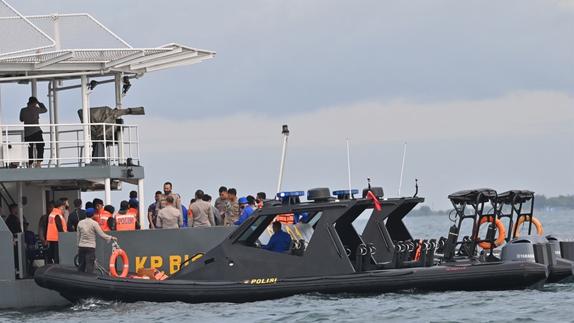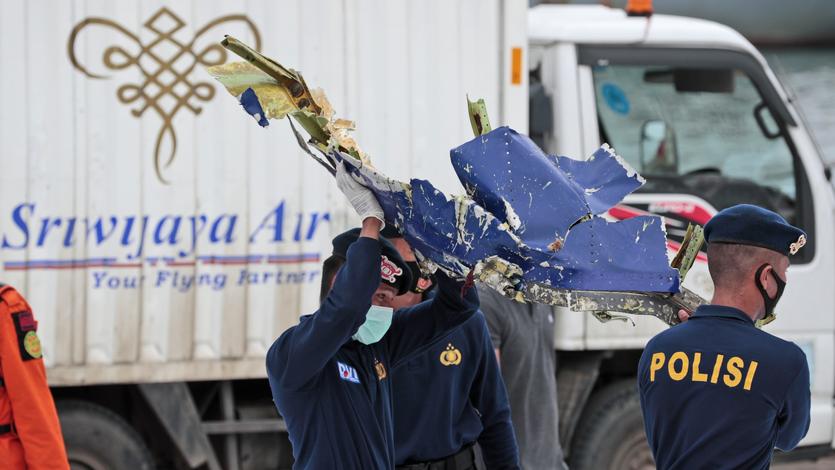 A marine police search and rescue team hold a briefing while conducting search operations at sea near Lancang island on Jan 10, 2021, where a Sriwijaya Air Boeing 737-500 is suspected to have crashed shortly after the jet took off from Jakarta airport on Jan 9. (ADEK BERRY / AFP)
A marine police search and rescue team hold a briefing while conducting search operations at sea near Lancang island on Jan 10, 2021, where a Sriwijaya Air Boeing 737-500 is suspected to have crashed shortly after the jet took off from Jakarta airport on Jan 9. (ADEK BERRY / AFP)
JAKARTA - The Sriwijaya Air plane that crashed last month killing 62 people had an imbalance in engine thrust that eventually led the plane into a sharp roll and then a final dive into the sea, according to a preliminary report by investigators on Wednesday.
When the 26-year-old Boeing Co 737-500 plane reached 8,150 feet after take-off, the left engine throttle lever moved back while the right lever stayed in its original position, Indonesia’s National Transportation Safety Committee (KNKT) said in its report.
We don’t know if it’s broken or not, but it’s an anomaly because the left moved far back, the right did not as though it was stuck.
Nurcayho Utomo, Investigator, Indonesia’s National Transportation Safety Committee
“We don’t know if it’s broken or not, but it’s an anomaly because the left moved far back, the right did not as though it was stuck,” KNKT investigator Nurcayho Utomo told reporters of the levers.
At about 10,900 feet, the autopilot disengaged and the plane rolled to the left more than 45 degrees and started its dive, according to the report.
ALSO READ: Indonesia plane crash probe centers on faulty system
Starting with just one plane in 2003, Sriwijaya has become the country’s No.3 airline group, aided by its strategy of acquiring old planes at cheap prices and serving routes neglected by competitors.
There had been two prior problems reported with the autothrottle system that automatically controls engine power based on maintenance logs, but the issue was rectified on Jan 5, four days before the crash, KNKT said.
A working autothrottle is not required for a plane to be dispatched as pilots can control the thrust levers manually with their hands.
Divers are still searching for the plane’s cockpit voice recorder which could help investigators understand the actions taken by the pilots, both of whom were experienced with 17,900 hours for the captain and 5,100 hours for the first officer.
READ MORE: Indonesia: Plane parts of crashed jet sent to US, UK for checks

The report highlighted the importance of upset recovery training for pilots and the recognition of repetitive plane defects, just over six years after an AirAsia Indonesia crash where those were among the issues raised.
KNKT said that following the crash Sriwijaya had taken safety actions, including adding upset recovery training in its next pilot proficiency check and reminding engineers that repetitive defects must be handled in accordance with safety manuals.
The airline sent a memo to pilots reminding them to write detailed reports to help engineers troubleshoot problems.
The report highlighted the importance of upset recovery training for pilots and the recognition of repetitive plane defects, just over six years after an AirAsia Indonesia crash where those were among the issues raised
The Directorate General of Civil Aviation also discussed the handling of repetitive problems and upset prevention and recovery training with other Indonesian operators after the crash, KNKT said.
Boeing said it would continue to support the investigation.
The preliminary report, as is standard, laid out factual information obtained to date but did not list the contributing factors to the crash. That will require further investigation.
If some part of the jet wasn’t functioning properly due to a technical problem, it could deal another blow to the US manufacturing giant as it emerges from the global grounding of its 737 Max following two other fatal crashes.
Safety experts say most air accidents are caused by a combination of factors that can take months to establish. Under international standards, the final report is due within a year of the crash.
 Police officers carry a part of aircraft recovered from Java Sea where a Sriwijaya Air passenger jet crashed, at Tanjung Priok Port in Jakarta, Indonesia, Jan 11, 2021. (PHOTO / AFP)
Police officers carry a part of aircraft recovered from Java Sea where a Sriwijaya Air passenger jet crashed, at Tanjung Priok Port in Jakarta, Indonesia, Jan 11, 2021. (PHOTO / AFP)
Sriwijaya Air Flight 182 crashed into the Java Sea four minutes after takeoff from Jakarta’s main airport on Jan 9, killing all 62 people on board.
The pilots were experienced and flying an aircraft with a relatively good safety record. Sriwijaya Air, despite being little known outside of Indonesia, has a solid history too, with no fatal crashes since its establishment in 2003.
But the crash was yet another blight on Indonesia’s poor aviation safety record, with two other major tragedies in recent years. In 2014, an AirAsia jetliner carrying 162 people went down in the Java Sea, killing all on board, and then in 2018 a Lion Air crash in the same waters claimed 189 lives.
The aircraft in the Lion Air crash was a Boeing 737 Max, which was grounded worldwide following another crash in Ethiopia the following March. Safety regulators are only just lifting their ban on the Max, which started flying again in countries including the US and Brazil at the end of last year. The grounding is still in place in several places, including China and Indonesia.
Boeing’s 737-500 has been involved in eight hull-loss accidents - where the aircraft isn’t repairable, according to Aviation Safety Network. The Sriwijaya Air crash was the third-deadliest involving the plane. Eighty-eight people were killed in a 2008 Aeroflot crash and another 68 died in an Asiana Airlines disaster in 1993. Investigators linked those to factors including pilot performance, training and weather.


